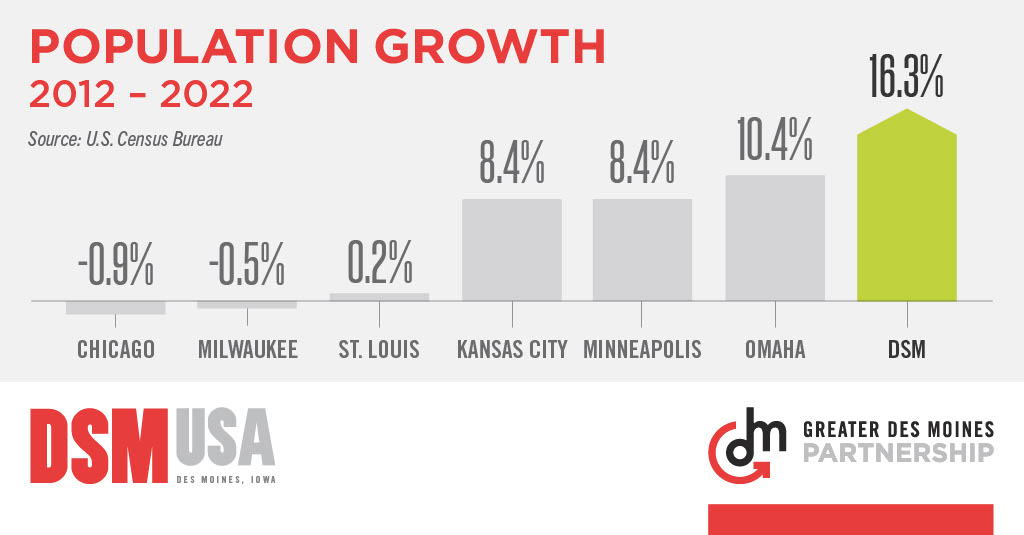Statistics
Greater Des Moines (DSM) is home to many business successes and has received numerous accolades over the past several years. These recognitions include being named a top metro for economic development projects, one of the top 10 cities to live and work, one of the best cities for jobs and among the top 10 places with the most job opportunities per capita. Such accomplishments can be attributed to DSM's talented workforce, impressive education ranking and strong business economy. The following economic, demographic and workforce data support DSM's successes and reputation as one of the best regions for business.
DSM USA Research, Stats & Data Hub
Utilize the DSM USA dashboard for economic, demographic and workforce data and visualizations for the DSM region and component counties. Bookmark the Hub and return often for updates.
Visit Data DSM USA
Demographics

DSM comprises 11 counties — Adair, Dallas, Guthrie, Jasper, Madison, Mahaska, Marion, Marshall, Polk, Poweshiek and Warren — totaling 850,481 residents (U.S. Census, July 1, 2022 estimate).
For detailed demographics and free ESRI reports on the region, its counties and communities, access the Areas tab in the LocationOne Information System (LOIS).
Cost Data
DSM celebrates its competitive business costs and affordable cost of living that help make it a top 10 city in which to live and work.
Living Costs
For DSM residents, it is typical to find combined living costs 10 – 12% below the national average, according to quarterly surveys by The Council for Community and Economic Research.
Cost of Living Index Calculator
Compare living costs and average prices in approximately 300 urban areas and the U.S. to those in DSM.
Business Costs
According to Moody's Analytics, the overall cost of doing business in DSM is 12% lower than the national average. The 2023 Standard New Employer Unemployment Insurance Tax rate for non-construction employers is 1.00% on a $36,100 taxable wage base.
Economic Indicators
Economic indicators ranging from growth in the workforce to population change to the number of building permits document DSM's momentum. The DSM USA Research, Stats & Data Hub features thousands of custom charts, graphs and data downloads for use in analysis and presentations.
In addition to the extensive resources in the Data Hub, the Economic Overview report (JobsEQ) provides a quick but comprehensive comparison of the DSM region, MSA and U.S., including wage rates and forecast data.
Workforce Facts

According to the National Center for Education Statistics, Iowa continues to reach the highest public high school graduation rate in the nation, 5.3% above the U.S. average at 91.8% (2020). The DSM region boasts over a 94.2% graduation rate for the Class of 2022 (Iowa Department of Education), and student scores on the ACT and SAT college entrance exams rank among the best in the country.
The DSM region's educational attainment is competitive with metros nationwide: 49.3% of residents aged 25 – 64 have an Associate's degree or higher (JobsEQ, 2023).
The 2023 Greater Des Moines Regional Laborshed Analysis estimates the labor force in the commute zone at 747,976 people. Major employers from key industries around the region tap into Iowa's talent to make their businesses more efficient and profitable. DSM also offers screening, assessment and testing services so that companies can select the right people. Training and reimbursements allow companies to save valuable time to train these workers up front.
Thanks to Iowa's job training program and campaigns such as Future Ready DSM, local internship programs and higher education institutions that work closely with local companies to collaborate to create curriculum programs based on key industry needs, DSM's labor force is thriving and continues to increase in size.
DSM Small Business Jobs Report
Download the 2022 DSM Small Business Jobs Report to see how small business leadership is being empowered throughout the region.